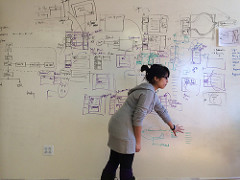Millennia Group Blog
Don’t forget to lock the front door
Tag and push is not a playground game
I admit, machines are smarter than me
Support your local decision maker
And the answer is…
Here’s a situation that is probably familiar to many. The company you work for has a database or some type of online application that contains information on your customers; CRM, accounting system, ERP, etc. The customer calls and has a question. It appears that some information was entered into the “system” but from experience, you know to double check.
The double check usually involves pulling up the original documentation. This lack of trust is not entirely unfounded nor irrational. There are many unintentional mistakes made when doing data input or possibly mis-interpretation of terms. What is the best way to ensure your employees always find out what the real answer is?
Steps in the right direction
- If you have a document management system, don’t let files and documents get uploaded without a minimum amount of meta data (descriptions) being associated with each file. This goes for folder based systems as well where users just drop files into the folders. For instance, have all client folders auto-generated based on a list from your accounting system or all prospect folders auto-generated from your CRM. Don’t let users create their own hierarchy or folder structure – take…
We feel guilty about tiny workspaces
Try doing less, it really works
Absolutely positively this is the one
Whatchamacallit
Collaboration requires collaboration
 Every business wants its staff to perform at its peak and to get one plus one to equal three through communication and collaboration. Collaboration can be complicated, even with technology. Maybe the best way to highlight how complicated collaboration can be, is to think about the creation of a report that summarizes a new project.
Every business wants its staff to perform at its peak and to get one plus one to equal three through communication and collaboration. Collaboration can be complicated, even with technology. Maybe the best way to highlight how complicated collaboration can be, is to think about the creation of a report that summarizes a new project.
The report could span multiple departments or even include inputs from outside parties. Therefore, security becomes an issue. Some collaboration may be parallel such as when working on budget numbers simultaneously in an online spreadsheet. Other collaboration may be sequential wherein the spreadsheet then provides input for the narrative part of the report – can’t start one without the other. The archival of the completed report needs to be managed as well. These are all issues that make any single technology solution a difficult fit.
To…














